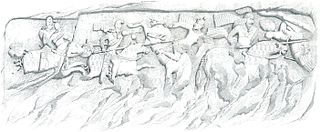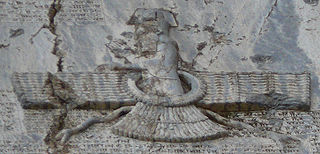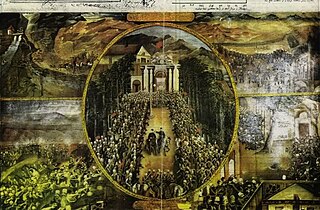 W
WThe Battle of Cunaxa was fought in 401 BC between Cyrus the Younger and his elder brother Arsaces, who had inherited the Persian throne as Artaxerxes II in 404 BC. The great battle of the revolt of Cyrus took place 70 km north of Babylon, at Cunaxa, on the left bank of the Euphrates. The main source is Xenophon, a Greek soldier who participated in the fighting.
 W
WThe Battle of Hormozdgan was the climactic battle between the Arsacid and the Sasanian dynasties that took place on April 28, 224. The Sasanian victory broke the power of the Arsacid dynasty, effectively ending almost five centuries of Parthian rule in Iran, and marking the official start of the Sasanian era.
 W
WCasualties of the Iranian Revolution refers to those who lost their lives during the Iranian Revolution. Observers differ on how many people died during the Iranian Revolution. The number of casualties during the revolution is either close to 60,000, or around 2,000, depending on whether the estimates used are those of Islamic government or from historians in Western countries. The number of protesters and political prisoners killed by the new theocratic republic after the fall of the Shah is estimated by human rights groups to be several thousand.
 W
WThe Iran crisis of 1946, also known as the Azerbaijan Crisis in the Iranian sources, was one of the first crises of the Cold War, sparked by the refusal of Joseph Stalin's Soviet Union to relinquish occupied Iranian territory, despite repeated assurances. The end of World War II should have resulted in the end of the Allied joint occupation of Iran. Instead, Pro-Soviet Iranians proclaimed the separatist Azerbaijan People's Government and the Kurdish separatist Republic of Mahabad. The United States pressure on the Soviet Union to withdraw is the earliest evidence of success with the new strategy of Truman Doctrine and containment.
 W
WThe Iranian Revolution was a series of events that culminated in the overthrow of the Pahlavi dynasty under Shah Mohammad Reza Pahlavi, and the replacement of his government with an Islamic republic under the Grand Ayatollah Ruhollah Khomeini, a leader of one of the factions in the revolt. The revolution was supported by various Islamist and leftist organizations and student movements.
 W
WThe Persian Revolt was a campaign led by Cyrus the Great in which the province of ancient Persis, which had been under Median rule, declared its independence and fought a successful revolution, separating from the Median Empire. Cyrus and the Persians did not stop there, however, and in turn went on and conquered the Medes.
 W
WThe Samanid Civil War of 888 was a conflict between the Samanid brothers, Nasr I, ruler of Samarkand and amir of all of the Samanid territories, and Ismail I, who was ruler of Bukhara and Khwarazm. The war took place three years after the Samanid Civil War of 885, which ended with a status quo ante bellum. This time, however, the war ended with a decisive victory for Ismail I. In the aftermath of the war, the victorious brother showed a great deal of respect to his elder and defeated brother and, according to a legend, Ismail even kissed Nasr's hand as a sign of apology. Apparently, Nasr lost much of his power, but he wasn't removed from the Samanid throne; instead, Ismail became de facto ruler of the empire and after death of his brother, he became the amir.
 W
WThe Sasanian civil war of 589–591 was a conflict that broke out in 589, due to the great deal of dissatisfaction among the nobles towards the rule of Hormizd IV. The civil war lasted until 591, ending with the overthrow of the Mihranid usurper Bahram Chobin and the restoration of the Sasanian family as the rulers of Iran.
 W
WThe Triumph of Tehran refers to the entrance of the pro-constitutionalists in Tehran on 13 July 1909, which led Mohammad Ali Shah Qajar to seek refuge at the Russian legation in Tehran, before he would be sent in exile.